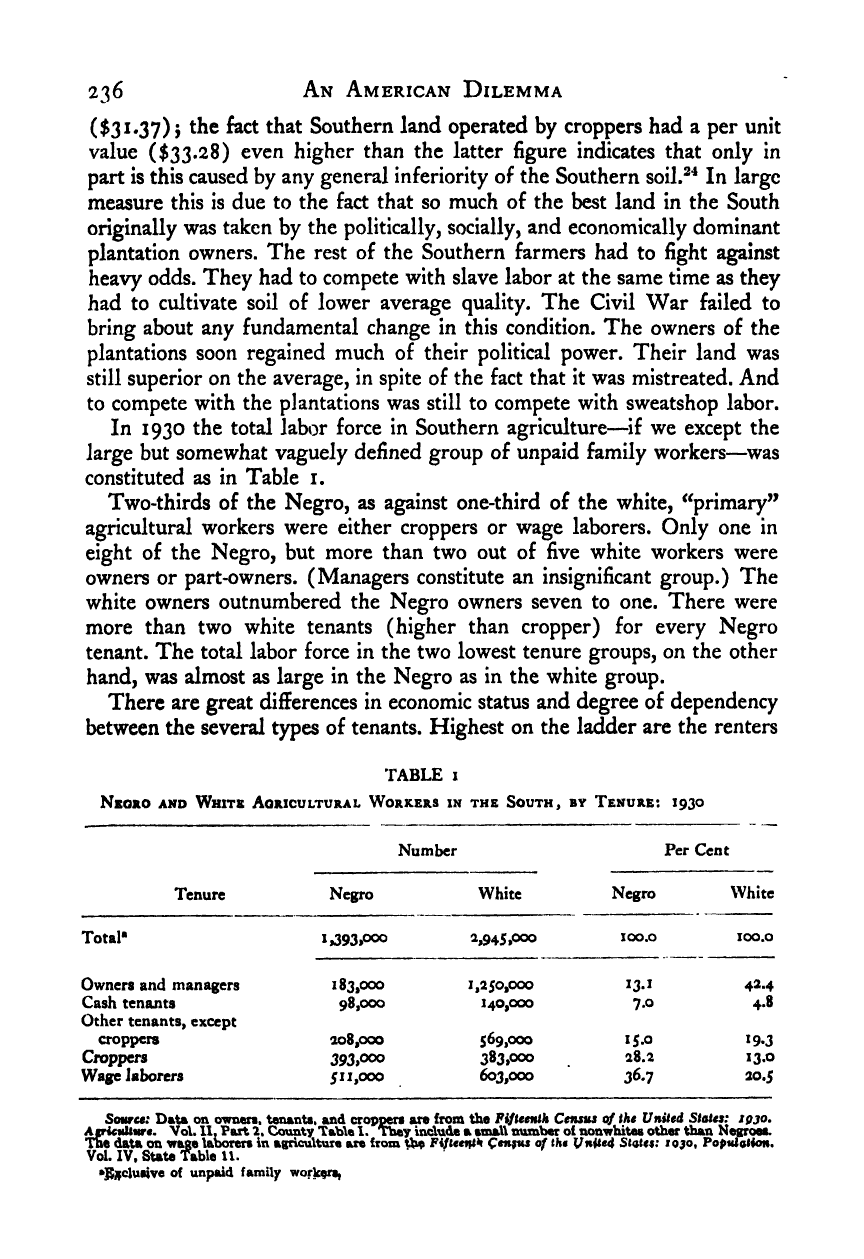Note: Gunnar Myrdal died in 1987, less than 70 years ago. Therefore, this work is protected by copyright, restricting your legal rights to reproduce it. However, you are welcome to view it on screen, as you do now. Read more about copyright.
Full resolution (TIFF) - On this page / på denna sida - IV. Economics - 11. The Southern Plantation Economy and the Negro Farmer - 5. Main Agricultural Classes

<< prev. page << föreg. sida << >> nästa sida >> next page >>
Below is the raw OCR text
from the above scanned image.
Do you see an error? Proofread the page now!
Här nedan syns maskintolkade texten från faksimilbilden ovan.
Ser du något fel? Korrekturläs sidan nu!
This page has never been proofread. / Denna sida har aldrig korrekturlästs.
236 An American Dilemma
($31.37) j
the fact that Southern land operated by croppers had a per unit
value ($33.28) even higher than the latter figure indicates that only in
part is this caused by any general inferiority of the Southern soil.^^ In large
measure this is due to the fact that so much of the best land in the South
originally was taken by the politically, socially, and economically dominant
plantation owners. The rest of the Southern farmers had to fight against
heavy odds. They had to compete with slave labor at the same time as they
had to cultivate soil of lower average quality. The Civil War failed to
bring about any fundamental change in this condition. The owners of the
plantations soon regained much of their political power. Their land was
still superior on the average, in spite of the fact that it was mistreated. And
to compete with the plantations was still to compete with sweatshop labor.
In 1930 the total labor force in Southern agriculture—if we except the
large but somewhat vaguely defined group of unpaid family workers—^was
constituted as in Table i.
Two-thirds of the Negro, as against one-third of the white, ^’primary”
agricultural workers were either croppers or wage laborers. Only one in
eight of the Negro, but more than two out of five white workers were
owners or part-owners. (Managers constitute an insignificant group.) The
white owners outnumbered the Negro owners seven to one. There were
more than two white tenants (higher than cropper) for every Negro
tenant. The total labor force in the two lowest tenure groups, on the other
hand, was almost as large in the Negro as in the white group.
There are great differences in economic status and degree of dependency
between the several types of tenants. Highest on the ladder are the renters
TABLE I
Nboro and White Agricultural Workers in the South, by Tenure: 1930
Number Per Cent
Tenure Negro White Negro White
Total* 1 ^93,000 l.945 .«» 100.0 100.0
Owners and managers 183,000 1,250,000 13.1 42.4
Cash tenants
Other tenants, except
98,000 140,000 7.0 4.8
croppers 208,000 569,000 15.0 19.3
Croppers 393,000 383,000 28.2 13.0
Wage laborers 511,000 603,000 36-7 20.5
Source: Data on owners, tenants, and croppers are from the Fifteenth Census 0/ the Unsted States: Jpjo,
Ajrieullure. Vol. 11, Part 2, County Table 1. They include a small number of nonwhites other than Negroes.
The data on wage laborers in agriculture are from the Fifuentk of the Vnited States: 1030, Population,
Vol. IV. Sute Table U.
*]Sj|cluBive of unpaid family workers)
<< prev. page << föreg. sida << >> nästa sida >> next page >>